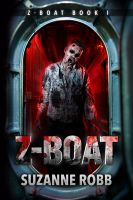
Suzanne Robb
Permuted Press,
ISBN 978-1618682345
March, 2014; $16.95 PB; $5.99 Kindle
Reviewed by Michael R. Collings
Reading Z-Boat is a bit like watching two of my favorite television shows simultaneously.
The first is an oldie-but-goodie series, Mission Impossible (1966-1973). Each episode began roughly the same way: first the baddies would be shown doing bad things for a few scenes. Then James Phelps (played by the inimitable Peter Graves) would shuffle through several pages of file pictures, selecting his crew for the emergency at hand…usually the regular cast. Only then did the primary action of the episode—defeating evil in various inventive, do-not-try-this-at-home-kiddies ways—begin, and from that moment on, no one got a chance to do more than take a quick breath.
The second series is more recent, NCIS, soon to be entering its twelfth season. A couple of years ago, I watched a discussion featuring the cast and producers. The question rose as to how the series managed to maintain its high rating among viewers. One of the staff said that early on in the series, the producers had decided to use more on-set cameras than had yet been used on a weekly television series and cut from one camera to another every five seconds or so. The effect: the sense of non-stop action, even when characters were relatively static: speaking or sharing information.
Blend the two, and you get Z-Boat.
The book begins with crisply written “Chapter One,” in which readers discover that something is horrifically wrong on a deep-sea submarine, although they do not yet know precisely what is wrong or where the submarine is. Then follows “Six Months Later,” as Brian Kingston, captain of the salvage submarine Betty Loo, summons enough sobriety to scan the files of those to accompany him on a secret rescue mission. He does not know exactly who has hired him; there are no nations anymore, only Firms—primarily Russia, Israel, and North Korea. He does not know the name of the submarine he is to locate, nor does he know precisely what he is after, only that he must return with “the item” and, as an afterthought, “survivors, if any.”
Readers next meet each of the various cast members, some belonging to the Betty Loo’s normal crew, others strangers to Kingston and to each other. And each of them has a SECRET. Something so crucial that the characters don’t even think about it until the book is well under way…and the Betty Loo is under weigh.
From that point, the story is non-stop movement, even though—as with NCIS—many of the scenes are dialogue. But the scenes and the subsequent narration are quick, often truncated, shifting rapidly from one character’s perspective to another’s. Many are told in a single paragraph. The result is that there is a breathless sense of urgency about the story, even though the first half contains little direct action.
Gradually, however, Robb reveals the deepest secret of all. The Peacemaker, designed to find alternative fuel sources and, perhaps most crucially, supplies of non-polluted water to be harvested, desalinated, and sold world-wide, has become infected by a poisonous-green bacterium with unique and terrifying properties. Essentially, it transforms its host organisms into zombies.
Robb mentions zombies in non-threatening contexts, including the declaration that “Zombies aren’t real,” so the revelation that they are real and that they constitute a threat to everyone and everything on earth does not come as a surprise. What does surprise are the ways Robb treats her zombies—yes, they are insatiably hungry for brains, but they also hunger for much, much more. Yes, they shamble at times, but at other times….
Unlike viewers of Misson Impossible or NCIS, readers of Z-Boat do not have the luxury of assuming that the main cast will survive to the end. As the action picks up—as it shifts between the Betty Loo and The Peacemaker 25,000 feet below the surface—not only do readers not know who will survive, they are not even certain who everyone is, who works for whom, who is ally and who is antagonist…and who will become the next victim of the bacterium.
Z-Boat is, as the subtitle indicates, the first in a series that will presumably chronicle the outbreak of zombiism worldwide. It may seem a bit slow at the beginning, primarily because it must establish—quite deftly, as a matter of fact—the context of a world two hundred years beyond our own, with its own political, social, and environmental concerns. But readers willing to go along with that pacing will soon find more action than they counted on.








